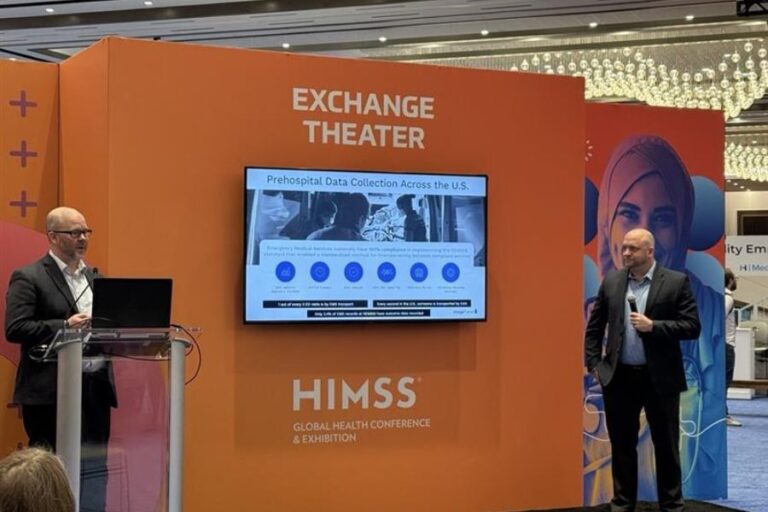This year’s Healthcare Information and Management Systems Society (HIMSS) Global Health Conference & Exhibition brought together thousands of industry professionals, innovators, and thought leaders from around the globe to tackle the most pressing challenges and opportunities in healthcare technology.
HIMSS25, held in Las Vegas from March 3-6, focused on four key themes: digital health transformation, artificial intelligence, cybersecurity, and workforce development. These interconnected areas reflect healthcare organizations’ move beyond basic digitization to more sophisticated applications as they navigate an increasingly complex technological landscape.
At the event were ImageTrend’s EVP of Product Michael Patock and Chief Growth Officer Joe Graw, who gave a presentation entitled “Uncovering Insights: The Impact of Prehospital Data on Hospital Patient Care and Operations.” Also at the event was Product Director of Strategic Development Doug Butler, who conducted a demonstration on integrating prehospital and EHR Systems during an interoperability showcase. Let’s dive into the key themes that defined this year’s event and what they mean for the future of healthcare technology.
AI and Cybersecurity: Defining the Future of Healthcare Technology
One of the biggest takeaways from HIMSS25 was the continued rise of AI-driven solutions across healthcare technology. Major players like Epic, Oracle, and Microsoft showcased their AI-driven innovations, particularly in clinical decision support and workflow automation. AI is no longer a futuristic concept—it is now a core component of modern healthcare technology, helping providers deliver faster, more accurate, and more personalized care.
However, as AI adoption grows, cybersecurity remains a top priority. With hospitals increasingly targeted by cyber threats, protecting patient data and securing interoperability systems has never been more critical. HIMSS25 featured an entire section dedicated to cybersecurity, highlighting strategies for strengthening healthcare IT defenses, mitigating risks, and ensuring compliance.
Beyond Hospital Walls: The Shift to Remote and Prehospital Care
Another key theme from the conference was the growing emphasis on healthcare beyond the traditional hospital setting. The keynote address underscored the need for expanded care outside of hospital walls, a movement that aligns closely with hospital-at-home programs, remote patient monitoring, and EMS integration.
This shift has significant implications for prehospital care, EMS, and community paramedicine. As hospitals focus on keeping low-acuity patients out of emergency departments, EMS plays a crucial role in bridging the gap between prehospital and hospital care.
The Power of Prehospital Data Interoperability
At the heart of this transformation is prehospital data interoperability—the ability to seamlessly share EMS data with hospital systems. In their HIMSS25 presentation, Patock and Graw highlighted why EMS data exchange is critical for improving patient care, optimizing hospital workflows, and enhancing operational efficiency.
1. Improving Patient Hand-Off and Clinical Decision-Making
One of the biggest challenges in EMS is ensuring that prehospital data is accurately transferred to hospital electronic health records (EHRs). Currently, many hospitals rely on manual data entry, incomplete patient information, and fragmented communication.
By integrating electronic patient care reports (ePCRs) with hospital EHRs, healthcare providers can:
- Save time and reduce errors during patient hand-offs
- Improve clinical decision-making by giving hospitals real-time access to EMS-collected data
- Enhance care coordination between EMS, emergency departments, and hospital teams
2. Why Data Exchange Needs to Be a Two-Way Street
While hospitals benefit from receiving EMS data, EMS agencies also need access to hospital outcomes. Unfortunately, EMS providers often never learn whether their initial assessment and treatment were correct.
Providing EMS agencies with hospital diagnosis, treatment, and patient outcomes offers several benefits:
- Improves clinical training and decision-making for EMS providers
- Reduces workforce burnout by giving EMS professionals closure on critical cases
- Enhances quality of care by refining EMS protocols based on real-world outcomes
For example, if a paramedic treats a suspected stroke patient in the field, they need to know whether their intervention was correct. Did the hospital confirm the diagnosis? Did the patient receive the appropriate treatment? This feedback loop is essential for continuous learning and improved patient outcomes.
3. The Financial and Operational Benefits of EMS Data Exchange
Beyond clinical care, prehospital data interoperability also has major operational and financial implications. EMS agencies often struggle with billing inefficiencies, delayed reimbursements, and administrative burdens.
By improving data exchange between EMS and hospitals, agencies can:
- Streamline billing and revenue cycle management by automatically receiving updated patient demographics and insurance details
- Reduce administrative burden by eliminating manual follow-ups and data entry
- Improve financial stability for EMS agencies, ensuring continued service for communities
Interoperability in Action: How EMS-Hospital Data Exchange Enhances Patient Care
As healthcare continues to evolve, prehospital data interoperability will play a critical role in shaping the future of patient care and hospital operations.
ImageTrend teamed up with Epic for an Interoperability Showcase, demonstrating how real-time EMS-to-hospital data exchange can streamline patient transfers and improve care coordination. Butler conducted the live demo, highlighting the seamless integration of prehospital data into EHRs and trauma registries, which eliminates manual data entry and ensures a continuous flow of critical patient information.
One practical example showcased was the automated exchange of physician certification statements (PCS) for interfacility transports, a process that traditionally involves significant administrative burden. This document is critical for EMS reimbursement, so digitizing the process eliminates delays. By enabling pre-alerts, automatic patient registration, and bidirectional data sharing, the solution reduces errors, enhances efficiency, and improves patient outcomes—all while supporting hospitals in cutting costs and optimizing workflows.
Overall, the demonstration reinforced the growing need for EMS-hospital interoperability, and how it allows first responders and healthcare teams to operate with complete, real-time patient insights for better decision-making and quality care.
Prehospital Data Is the Future of Healthcare Connectivity
Looking ahead, the evolution of EMS data exchange will be driven by AI, standardization, and expanded use cases.
- AI-powered analytics will help EMS agencies and hospitals derive deeper insights from prehospital data, improving predictive care models and resource allocation
- More standardized data exchange protocols will ensure seamless interoperability between EMS and hospital systems
- Greater recognition of EMS as a vital healthcare partner will drive policy changes that expand EMS access to hospital outcome data
As the demand for seamless data exchange grows, prehospital data interoperability will play a critical role in shaping the future of patient care and hospital operations. HIMSS25 reinforced that seamless EMS data exchange isn’t just a nice-to-have—it’s a necessity.
By prioritizing interoperability, hospitals and EMS agencies can work together to improve patient outcomes, enhance operational efficiency, and build a more connected healthcare ecosystem.




